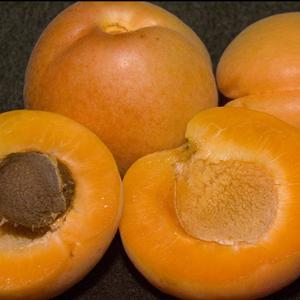Pluots, Apriums, Plumcots, Apriplums

Flavor Delight Aprium is a cross between an apricot and a plum. Maybe called an aprium because is resembles an apricot more than a plum.
Inter-specific Hybrid Stone Fruits Are Complex New Cultivars
Luther Burbank was one of the most prolific fruit and plant breeders of all time. Some of the crosses that he made are called inter-specific hybrids, because they are new varieties that are bred by controlling the parentage to a greater extent than most breeders do. Most of the new inter-specific hybrids now have been bred by Paul Zeiger and his family, who have followed in Burbank’s shoes and have a prolific breeding program in California.
What is an inter-specific hybrid? It is called that because each parent is from a different species of the stone fruit genus “Prunus”. Normally these different species do not cross in the wild because of different bloom periods and slight genetic differences that need to be overcome by the breeder. Any progeny from the cross or breeding of two different species is called a “hybrid”. Often times hybrids are sexually sterile and cannot propagate themselves later on— the best example is a mule, which is the progeny of crossing an ass or donkey and a horse. Hybrids often combine the best traits of both species. Most times the species must be of the same “family” genus in order to be closely enough related for their genes to match up and reproduce.
Anyway, to avoid being too scientific, Burbank and Zeiger learned how to successfully cross many of the different species within the stone fruit family genus that includes peaches (nectarines are just fuzzless peaches because of one or two “fuzzless” genes), apricots, plums and prunes (same thing), cherries, and some other stone fruits like almonds. By raising parent plants under more controlled conditions such as in greenhouses and where they could move them in or outside and control their development, they could have both targeted parents, such as a plum and an apricot, bloom close enough together that they could hand harvest pollen from one parent and use it to pollinate the other parent’s blossom. If they chose the right parents, and with a lot of luck, the pollinated blossom will set a tiny fruit which they can then grow to maturity. From these fruits, they harvest the seeds, and often with another dose of hard work and technical expertise they could then get those seeds to germinate and grow. These progeny or children are allowed to grow and fruit, which may take several years. If the fruit has suitable qualities, then they may be chosen for further evaluation and possible introduction as a new fruit cultivar or variety.
While this may seem like magic, it is how almost all of the fruit varieties that have been “bred” and introduced into consumption have come about. This also happens in the wild, and many of the old heirloom varieties came about by this kind of “sex” happening by chance and not by human control. PLEASE BE ASSURED THAT THIS IS NOT “GMO”! None of the fruit varieties that Grandpa raises or sells have been gmo’d or genetically manipulated to include genes not normally present in a species— so none of the fruits we sell will glow in the dark! [This subject is very controversial and should be dealt with in another article. There is a lot of misconception and fear about the new genetics.]
So, Zeiger has been able to successful cross many different stone fruits in the same genus and come up with new varieties of stone fruits such as Pluots, Apriums, Plumcots, Apriplums, and some I don’t even know about! You find many of these fruits in the stores now in the produce isle. Because of all the hard work put into breeding them, and their uniqueness, they can be plant patented and trademarked, and almost all of these new fruits are still patented, their propagation tightly controlled, and their marketing as plants restricted in many cases.
Grandpa has just started to offer some of these inter-specific hybrids when he can find ones that he may offer without violating Zeiger’s patents or trademarks. Zeiger’s are entitled to their patent protection, which is common in the fruit and nursery industry, and Grandpa isn’t about to make enemies! As more varieties become available, he will try to offer them.
In general, these hybrids combine the traits of their parents and so can have some unique and interesting taste, flesh, and appearance characteristics. Why one is called a Pluot versus being called a Aprium is something I don’t understand yet.
So, this seemed to turn a complex topic into a complex and lengthy explanation. Sometimes it just can’t all be simple!
- Plouts are plum/apricot hybrids. If you’re interested in growing this fruit you might try our Flavor Supreme.
- Did you know nectarines are self-fertile and can be planted by themselves? Try Grandpa’s Choice™ Hardired nectarine, which ripens in early August.